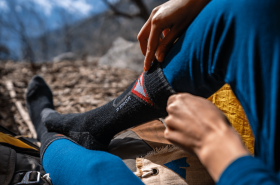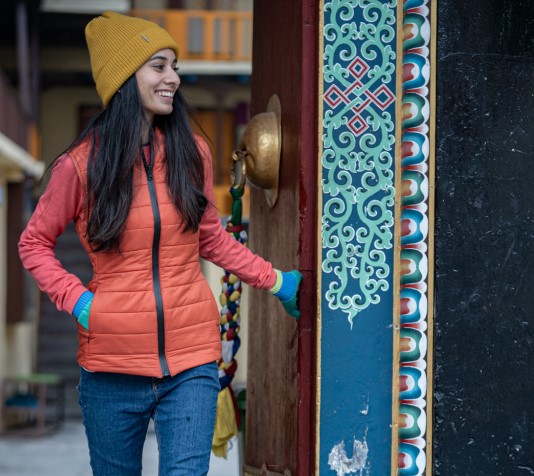Need information about Pashmina Wool, let’s help you!
It’s an amazing sensation to be anticipating the winter and the freezing weather that will accompany it, while this most awaited season brings along a unique charm and delight. It’s the time of the year when your long hibernating winter wear is out of the wardrobe. It is also the time of the year when your favourite pashmina can be snugly draped around you.
Having a pashmina has been a women’s dream from the start, and it has been around the world, across all genders, races, ages, and cultures. There were absolutely no limits when it came to having a pashmina. made in Kashmir would reach Europe and America alike and would be appreciated by any admirer of the craft.
The rich pashmina is suggestive of taste, beauty, and elegance. Even if it is simple, it still manages to enhance the appearance of the wearer, especially when it is combined with an appropriate set of clothes. Designers use special fabrics, patterns and threads for the creation of such shawls and some of their pashminas can be called true works of art.
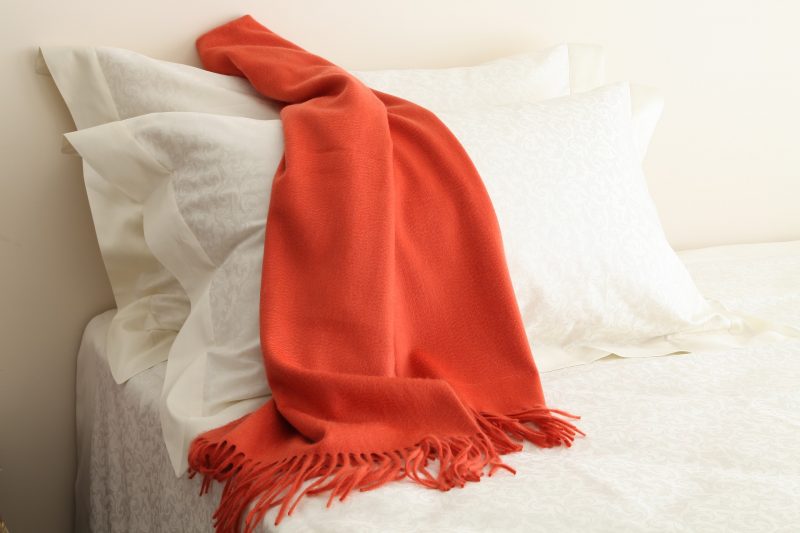
Handmade Pashmina wool scarf
Pashmina Wool – How to choose, history and FAQ
What is Pashmina? Is Pashmina a type of wool?
Some products become symbols of luxury and a fine lifestyle. Pashmina shawls and stoles are one such symbol of handmade luxury with their rich soft beauty. The products are spun, woven, and embroidered from pashmina goat wool by hand, making each pure piece quite expensive.
Pashmina is the traditional name for the finest cashmere wool. Also known as the diamond fabric and the soft gold of Asia, pashmina is the finest, softest and warmest wool available. Derived from the Persian word “pashm”, it refers to the undercoat of fur obtained from certain species of goats.
Pashmina is the epitome of luxury, warmth and gives you an experience of 100 percent pure bliss. It is versatile and can be used in creating several products, such as shawls, stoles, scarves, blankets especially for babies, half sweaters, socks, gloves, sweaters, cardigans, hats, and even coats. Soft, cosy, and lightweight, a pure pashmina product is simply hard to resist.
History of Pashmina
Kashmir is known around the world not only for its natural beauty but also for the production of the best quality scarves and shawls made by Kashmiri artisans. Pashmina scarves, first woven in India, are the staple handicraft of the Kashmir Valley.
Known for their softness, elegance, and desirable aesthetic value, pashmina shawls today enjoy their own exclusive status of popularity around the world.
Pashmina Shawls are an extraordinary art in Kashmir. Other countries have tried to replicate this art but failed. These scarves are weaving fabrics that have been practiced by generations of people who have practiced this craft and inherited this art from their ancestors.
An authentic, whisper-soft Kani Kashmiri pashmina scarf is passed on from generation to generation. An original Kani scarf is a fashion accessory that has proven itself and is always in fashion. Kani pashmina has always been the fabric of choice of Sikh Maharajas, British and French aristocrats, and Mughal kings. The authentic pashmina is made from the traditional Kashmiri art of weaving that has been passed down from generation to generation.
Crafted by weaving, they created designs with floral borders.,chinar leaves and paisley patterns, mostly from memory, inspired by lakes, sunrise and sunset. The main embroidery on the pashmina scarf is sozni, paper mache and aari.
Shahtoosh is also a ball of fine wool made from the hair of the Tibetan antelope. It is also a metonymy for a type of cashmere scarf traditionally made from shahtoosh wool. Like real pashmina, shahtoosh comes from the Himalayas, but instead of goat hair, shahtoosh is made from the curls of chiru, a species of antelope native to the Tibetan plateau in China.
There are several stories on how pashmina was introduced. The origin of Pashmina dates back to ancient civilization. During those days it was renowned as the “Fibre for royals & emperors.”
Value of a Real Pashmina
Even though dealers promote their Pashmina, faux or actual, at identical prices, however actual Pashmina is certainly a touch more luxurious than its inexpensive copies. But, how much does an actual pashmina cost? The rate relies upon more than a few things like ply, count, and weaving design.
Ply
Ply is the density of the fiber from which a scarf is made. A single pashmina layer would mean that the base yarn is worn in its unique shape. Double-ply or two-ply layers would indicate that the fiber is double twisted. The double layer is more expensive as it gives more resistance to the scarf made. A single-layer scarf would be more delicate, transparent and cheaper than the two-ply.
Yarn count
A yarn count is a number that indicates the meters of yarn that can be spun per gram. The more yarn, the finer, softer, and more elegant the scarf, therefore a pashmina scarf with 100 threads would mean that one gram of the scarf would be 100 meters of yarn and the fiber would be more delicate.
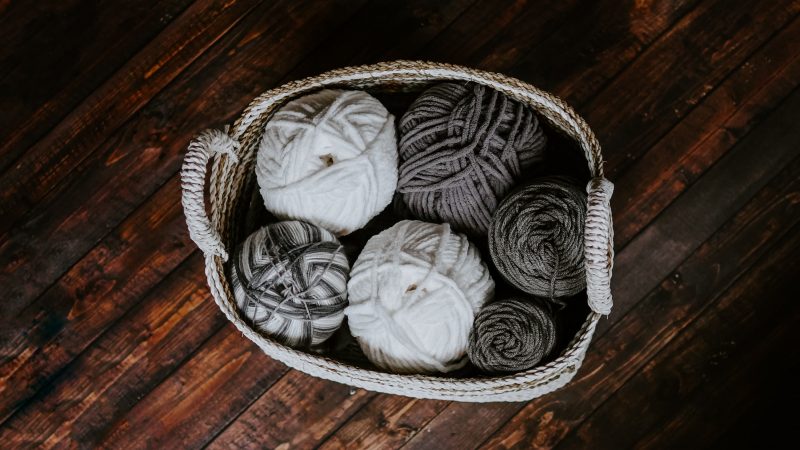
Pashmina Wool Yarn
This type of pashmina would be more expensive because the finer the fiber, the more carefully it is made.
The thickness of the Fibre
If the fibre used is thick, the Pashmina would lose its essence, and hence be less expensive. The finer the fibre used, the more pricey the shawl becomes. Besides, it is believed that the finer the fibre used, the warmer the shawl is.
Price and where to buy Pashmina
It is not just more or less embroidery or motifs that determine the price of a pashmina scarf, the price of a pashmina scarf depends on a number of factors that both sellers and buyers ignore and then ask themselves why the scarf is expensive.
The purity of pashmina is determined by the amount of silk that is mixed in it. The more silk there is in the product, the “diluted” the pashmina becomes. This also lowers the price, as a silk/pashmina scarf is priced even below a pure pashmina stole. Similarly, wool or cotton is added to Pashmina to add weight to it, and this reduces the amount of pure pashmina used and lowers its cost.
Pure pashmina is priced high, and a stole can cost anything from Rs. 750 to Rs. 1000. Similarly, pure Pashmina shawls are sold for close to Rs. 2000 to Rs. 3500.
The most expensive pashmina products are those with kayini work, embroidery that is done entirely by hand. The workers meticulously cover every inch of the cloth with elaborate pattern embroidery and give the product a colorful & vibrant look.
Each Kayini scarf lasts almost six months and costs between 45 and 65,000. Despite the high price, pashmina has quickly become a very desirable commodity and most of the tourists visiting India have this item on their shopping list.
Pashmina shawls, shawls, and stoles are sold in specialty stores across the country. In New Delhi, markets specializing in ethnic products boast about clothing made with pure pashmina. Dilli Haat is one such shopping area where pashmina is available, both in its pure form as well as the comparatively cheaper options.
How to wash Pashmina Wool
Generally speaking, dry cleaning is the preferred method of washing Pashmina and cashmere. However, if you are careful and follow the guidelines below, you can wash your pashmina shawls at home from time to time.
Always handle your delicate shawls with clean hands. Start by washing your hands with cold water. Use mild detergents, such as baby shampoo or lanolin for washing. Ensure the detergent is completely dissolved before soaking in the shawl
Then wash by hand very gently, without being rough. Be very careful with the knotted tassels when washing cashmere accessories.
Rinse off using cold water. After washing, lay the shawl flat on a clean surface instead of hanging it. Avoid using the dryer.
You can iron your pashmina scarf after drying, but it is best to put a piece of paper or cloth between the iron and the fabric. Always use a mild heat setting on your ironing appliances.
Additional Tips: You shouldn’t use fabric softeners in pashmina. Fabric softeners are full of chemicals that can do more harm than good to your pashmina. However, if you have no choice but to wash it in it, use less fabric softener and rinse your pashmina thoroughly (but gently)
Also, you cannot bleach pashmina as it can greatly affect its smoothness. Always use cashmere or pashmina washing shampoos, or even better, have your precious item delivered to the dry cleaner.
Difference between a pashmina shawl and a simple shawl
There is a huge difference with respect to the quality of workmanship, quality of premium raw materials, and quality of higher levels of technology.
Both pashmina and cashmere refer to the same quality of wool; however, pashmina is the Indian colloquial word whereas cashmere is the anglicized word.
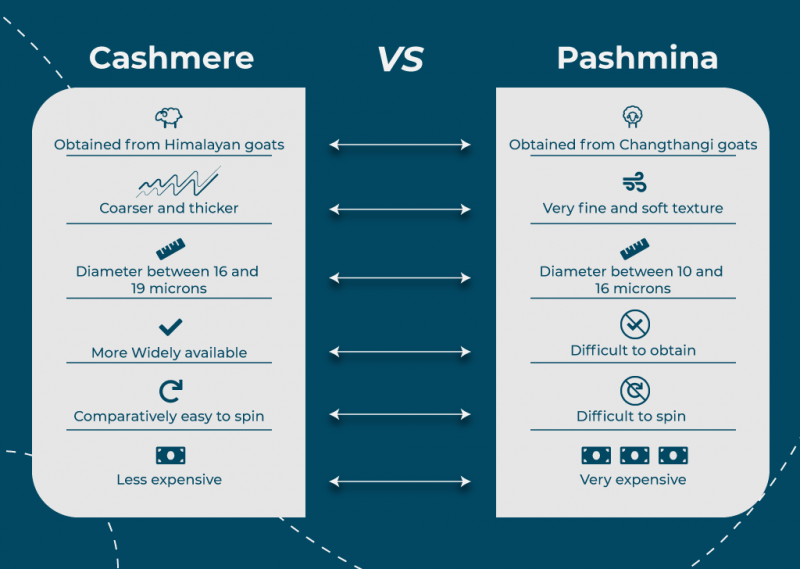
Comparison of cashmere & pashmina wool
Scarves can be made of wool, silk, or even a mixture of viscose, polyester, and acrylic. The shawl can be made from Merino wool on a manual or mechanical loom. Making a cashmere scarf requires a lot of skill, experience, or skill.
A shawl can be made on a handloom or a power loom from merino wool. It does not require immense skill, expertise, or proficiency in making a pashmina shawl.
Given the high demand, special prices, limited supply, and its truly extraordinary characteristics make Pashmina shawls and scarves are a great example of Veblen products.
Difference between a pashmina shawl and merino wool shawl
There are quite a few differences between a pashmina shawl and a merino wool shawl.
As far as pashmina wool goes, it is the finest wool yarn extracted from the belly of the Changthangi goat (also known as the pashmina goat) This, in turn, has technical reasons, and most importantly, the wool of these goats is only a few microns thick. 1215 microns.
In contrast, the thickness of the hair on our head is 100 microns, while the thickness of Merino wool (the most common type of wool) from Merino sheep is 24- 30 microns.
Kosha offers a wide variety of fashion wear and accessories made out of merino wool, which is known for its lightweight and unmistakable warmth.

Kosha’s Merino Wool Scarf
Be it anything from a merino blend reversible sweater, merino wool basket knit thermals, to warm and cozy cardigans, Kosha offers it all, designed with meticulous details keeping your comfort and congenial choices as our utmost priority.

Kosha’s Knitted Wool Scarf
At Kosha we have scrupulously designed products like
Merino Blend Full Sleeves Cardigan
A high-quality cardigan is a timeless winter design that is versatile and super cozy. Made from soft merino wool, which is naturally odor-repellent, moisture-wicking, and skin-friendly, it is ideal for travelers or long winters.
Merino Wool Bamboo Thermal
Our Reinvented Thermal made of merino wool and bamboo is softer on the skin and light. Its temperature-regulating properties reduce the risk of catching a cold when leaving the central heating.
Merino Wool Liner Regular Socks
Made specifically for your next trip, leisure, for adventure, our extremely comfortable socks will help keep you warm in winter by wearing the right layers. The air trapped between the layers stores the warmth of our body.
Merino Wool & Bamboo Thermal Bottoms
These amazing thermal bottoms are made out of It is a temperature regulating fabric that keeps you warm in extremely cold climates and cools you in hot temperatures. Fine bamboo fibers make it soft and cool to wear, while merino wool fibers keep you warm and stop the stench that thrives on high-performance outdoor activities.
Here are some of the most popular scarves from the Kosha store
- Lime Merino Wool Chevron Knit Muffler
- Lava Grey Merino Wool Diamond Rowed Muffler
- Ltd. Ed. Champagne Modal Plain Stole
- Ltd. Ed. Onyx Diamond Weave Wool Stole
You can access all the scarves here
More about Pashmina Wool: FAQ
How is pashmina wool made?
An authentic pashmina is always handmade and hand embroidered with a very minute thread. Only a talented craftsman can laboriously create skillful scarves that give pashmina its grace and splendor.
Depending on the work, a single piece of pashmina can take anywhere from a week to a decade to complete.
Creating a garment in cashmere is a complex and long process.
Pashmina goats are found only in areas of high altitudes. These goats shed pashmina in spring, which is combed off and collected.
A very delicate and skillful pashmina extraction method is used where the goats are not harmed and more fibre can be collected every spring from the same goat for many years. This technique is usually passed on from one generation to another.
An average of 450-500 grams of raw pashmina is collected per goat which is then processed to produce Cashmere or pure Pashmina yarn which is very soft and warm.
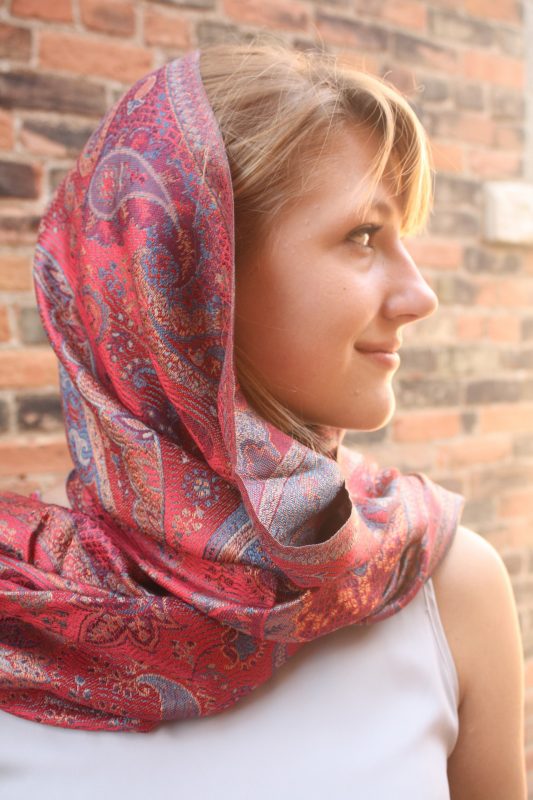
Pashmina wraps
Why is Pashmina so exquisite?
Pashmina has an unrivaled status as a luxury fibre due to its extreme finesse, softness, scarcity in relation to other fibres & its mystique. Being unique and exclusive, a pashmina product makes a distinctive style statement. There are no set rules laid down when it comes to wearing a pashmina stole.
Gently twine it over your shoulder, letting both the ends dangle loosely from each side, or wrap it snugly around your neck when it’s cold outside. Drape a chic stole that is not only stylish but is guaranteed to suit a wide variety of outfits, displaying your elegance and beauty at the same time.
Not only today pashmina has the patronage of the whole world, but there were also times when this art was favored by royal patronage, kings, queens, royal families and nobles from all over the world knew pashmina, in fact, they owned a large number of scarves.
Factors that determine the quality of pashmina are its delicacy, length, and fiber color. Raw pashmina is available in colors ranging from white, which is considered to be the highest quality, to brown and gray. and it is measured in micrometers, i.e. 1/1000 of a millimeter.
The Changthangi goat’s pashm is 13 to 19 micrometers in size. The fiber length suitable for hand knitting “pashm” is more than 5 cm. Changthangi goats that live at higher elevations produce longer pash fibers.
How to store a Pashmina shawl or scarf when you are not wearing it?
It is important to take good care of your woolies, such as a pashmina shawl. Here is how
First, clean the shelf or generally the place where you keep your pashmina. It must be well clean and free from moisture.
After cleaning, you need to protect it from moths as these can easily attack your luxurious pashmina. You can put some anti-moth paper on the storage shelf and use naphthalene balls to prevent pests from attacking your scarf. Do replace them when they get old, as naphthalene balls will dissolve over time.
We recommend not to store pashmina in plastic bags for more than a few months. It can change the color of your pashmina. Instead, try wrapping your deluxe pashmina in acid-free tissue paper to keep it in its original shape. Also ensure it is protected from dust and moisture.
Is pashmina better than cashmere?
So, the first difference is the goats that produce this wool. In the case of pashm wool, only Tibetan goats found during the winter period at altitudes above 4000 meters can produce this wool.
On the other hand, just like pashm wool, cashmere wool is produced from the undercoat of goats, but this time the manufacturers use different subspecies of goats that live in a wider area.
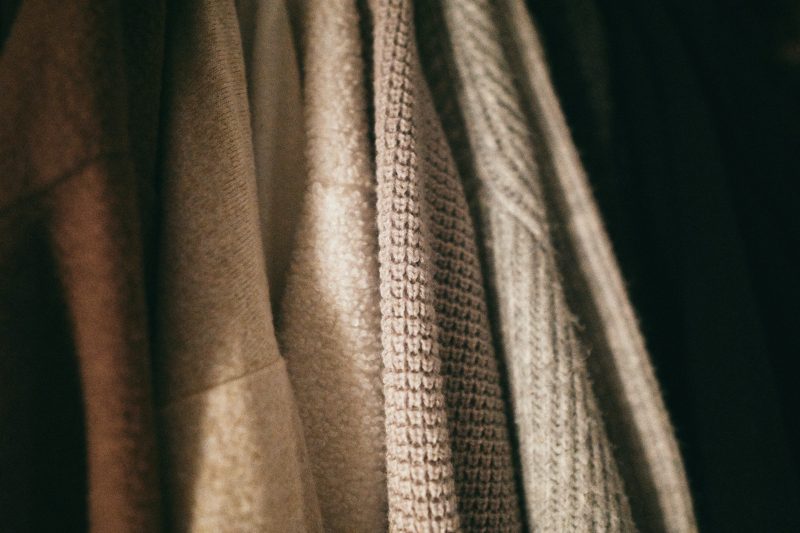
Handwoven pashmina cardigans
Cashmere wool is a lot easier to find. There are more than 400 million cashmere goats worldwide. Made in Kashmir and Nepal for thousands of years.
Both the pashmina and cashmere scarves are from mountain sheep, the main difference between them is the diameter of the fiber. ideal for the production of light garments such as fine scarves.
Pashmina is a more refined version of cashmere products. However, both variants have exceptional qualities and are now considered to be one of the most luxurious fabrics in the world.
Conclusion
Pashmina, when blended with silk or wool, can be lovely and appealing to some as it may offer good-quality cashmere at affordable prices. But if authenticity and using products made by the finest material is your way, then pure pashmina products will be the best addition to your wardrobe. They are the perfect gifts to make your friends and family feel special and loved.
Delicate and elegant, they are certainly a worthy accessory.
